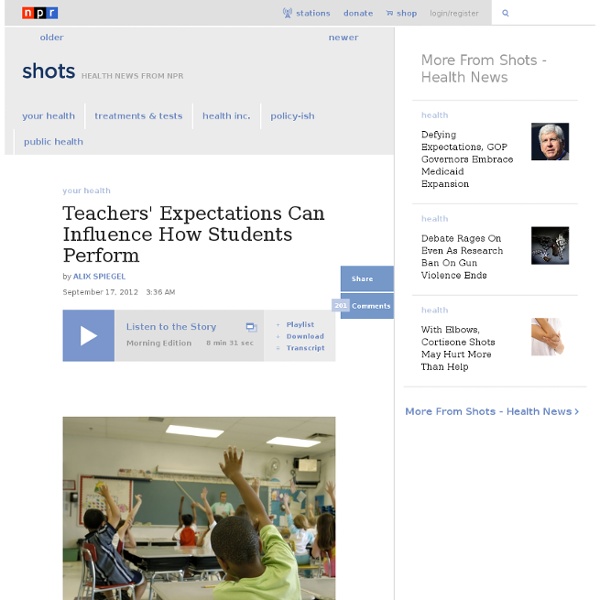Building Resiliency in Struggling Students: 7 Key Ideas from Research
In the coming weeks, millions of students across the country will return to school. Countless numbers of them will be labeled with such terms as at-risk or high-risk for academic failure or inappropriate behavior. As educators, we strive to find interventions, strategies, and programs that will help these students be successful. Resiliency can be defined as the ability to persist in the face of adversity or the ability to bounce back after facing a challenging situation. Helping students develop resiliency skills and attitudes has a positive effect on academic achievement, behavior, and long-term success in life (Hanson & Austin, 2003). With this in mind, here are seven key ideas to help struggling students become resilient: Avoid labeling children as “high-risk” or “at-risk.” Post submitted by Bryan Harris, director of professional development for the Casa Grande Elementary School District in Arizona.
36 Things Every 21st Century Teacher Should Be Able To Do
What should every teacher in the 21st century know and be able to do? That’s an interesting question. After just now seeing this excellent post on educatorstechnology.com, I thought I’d contribute to the conversation. I added the twist of ranking them from least complex to most complex, so novices can start at the bottom, and you veterans out there can skip right to 36. 36 Things Every 21st Century Teacher Should Be Able To Do 1. Whether you choose a text message, email, social media message, Skype session, or a Google+ Hangouts depends on who you need to communicate with and why—purpose and audience. 2. Email won’t always work. 3. Hit the Print Screen button near your number pad on a keyboard on Windows. 4. Know what it means to be Rick Roll’d, the difference between a fail and an epic fail, why Steve is a scumbag, and who sad Keannu is. 5. Not everyone loves technology. An RT as an olive branch. 6. 7. Tone is lost when you type. 8. This is dead-simple, but you never know. 9. 10. 11. 12.
Are textbooks an obstacle to learning? SmartBlogs
In “We Don’t Need No Stink’n Textbooks,” Tom Whitby convincingly argues that textbooks are as obstructive to learning as they are ubiquitous in American classrooms. He suggests that most teachers’ inability to emerge from their comfort zones — of which textbooks are an essential component — hinders them from utilizing the incomparably better resources available throughout the Internet. Whitby is certainly correct: Textbooks are an obstacle to learning, and teachers rely on them extensively nonetheless. However, moving beyond textbooks requires a more penetrating solution than curating the Internet under the guise of a digital textbook as suggested in the article. The reliance on textbooks runs deeper than habit; it’s a product of intellectual laziness. In other words, we need to elevate the conversation. Textbooks have given several generations of educators a “pass” on confronting the difficult conversations surrounding the big ideas of a classroom.
The most important skill for college-bound students | Sia Knight Consulting
Share this: Google+ Sia Knight Related posts: Category: College Admissions Assistance, Uncategorized Tag: academic coaching, college application, college coaching, college planning, high school, junior year, middle school, senior year, STNT, testing One comment on “The Most Important Skill To Teach Your College-Bound Student” Jose JR Vazquez on said: Sia,So glad someone said Number #2! Leave a Reply Your email address will not be published. * Copy This Password * * Type Or Paste Password Here * You may use these HTML tags and attributes: <a href="" title=""><abbr title=""><acronym title=""><b><blockquote cite=""><cite><code><del datetime=""><em><i><q cite=""><strike><strong>
10 Ways to Deal with Difficult Students
We all have those students who are habitually in trouble or are making trouble. This classroom management post is for all the teachers who struggle to reach those kids who snarl when you look at them, recoil when you are near them, and refuse to do what they are asked. Here are ten classroom management suggestions on how to deal with these difficult students: Stay in contact with parents Make sure they know what is going on; how often he is in trouble, and what trouble it was. A few teacher interview questions that you should be able to answer without... Some experts and educators favor the elimination of grades. Teaching strategies to ensure that your introverted students are feeling valued... Here are a few things that teachers shouldn’t be doing this summer break. A few classroom management ways to model effectively. Use proximity to limit negative actions When at all possible, place the student nearest you (hard when you are immersed in PBL) or stay within close proximity to him.
Lee Kraus' Blog | Learning Online
I Let Them Fail.
I let my students fail. I actually walk away and allow it to happen. I don’t intervene. I don’t just try to make it easy. Because when I let them fail, they engage.
FREE -- Teaching Resources and Lesson Plans from the Federal Government
FREE Features These features originally appeared on the FREE.ED.gov features blog. The features highlight resources and ideas related to holidays, awareness months, anniversaries and seasonal topics. January February March April May June July August Back to School: 7 Ways to Help Kids Transition Back to the Classroom September October November December About FREE Federal Resources for Educational Excellence (FREE) offered a way to find digital teaching and learning resources created and maintained by the federal government and public and private organizations. FREE was conceived in 1997 by a federal working group in response to a memo from the President. Technology has made it increasingly easier to find information from government agencies or with custom search tools, like Kids.gov. FREE Disclaimer The U.S.



